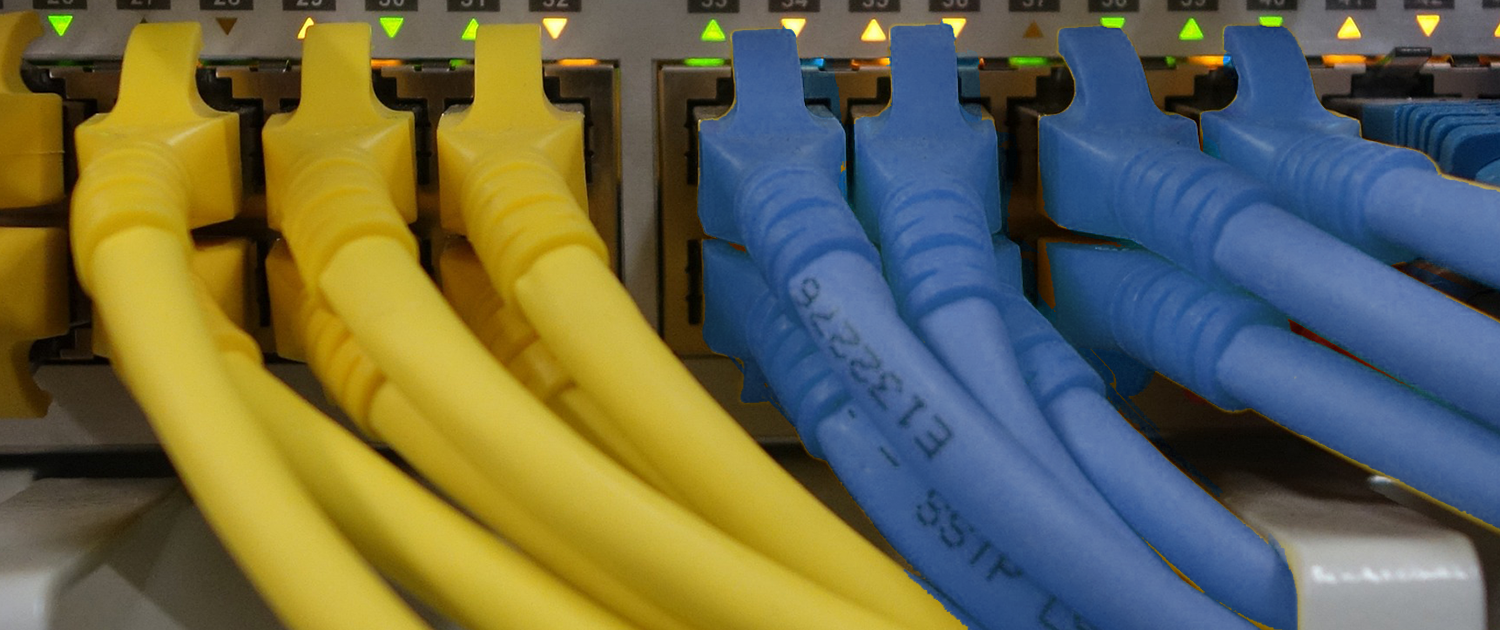It has been a year since Russian forces moved into Ukraine. Since then, Ukraine’s Internet connectivity has been affected by the ongoing war, particularly in the southern and eastern parts of the country where fighting has been heaviest.
Last year, Time covered in detail how Internet infrastructure is being targeted in Ukraine and how volunteers are helping restore the infrastructure wherever possible. The New York Times also published a piece on how Internet traffic from the Ukranian city of Kherson is being diverted through Russia.
We decided to look at what’s happened to Ukraine’s Internet using Internet number resource (IPv4, IPv6, and ASN) allocation data to see how things have changed from February 2022 to February 2023.
A Quick Overview of Internet Number Resources
The Internet is a collection of networks, nearly 77,000 to be precise. In general, every one of these networks autonomously maintains how the traffic flows within it and is called an Autonomous System (AS). To identify these networks — or ASes — across the global Internet, every network is assigned a unique number: an Autonomous System Number (ASN). Just as every network needs a unique number, every device connected to the Internet also requires a unique number, otherwise known as an Internet Protocol Address (IP address), either IPv4 or IPv6.
IPv4 and IPv6 address space and ASNs are collectively known as Internet number resources and are allocated by the five Regional Internet Registries (RIRs). Anyone operating a network can become a member of an RIR and request Internet number resources. Ukraine’s ASNs and IP address space are allocated and administered by the RIPE NCC, the RIR for Europe, the Middle East, and parts of Central Asia.
The Number Resource Organisation (NRO), the coordinating body for the five RIRs, makes all ASN, IPv4, and IPv6 address allocation data public via its daily delegation file.
ASNs
On 5 February 2022, the NRO delegation file suggests that there were 2,197 ASNs allocated to networks in Ukraine (Figure 1). As we can see, there has been a lot of movement over the past 12 months, which is not uncommon.
At one point, 2,199 ASNs were delegated to networks in Ukraine. The decline in the number of ASNs means that either the ASNs have been returned to the available pool by the networks in Ukraine or the holder of the ASN changed the country of origin from UA to something else.
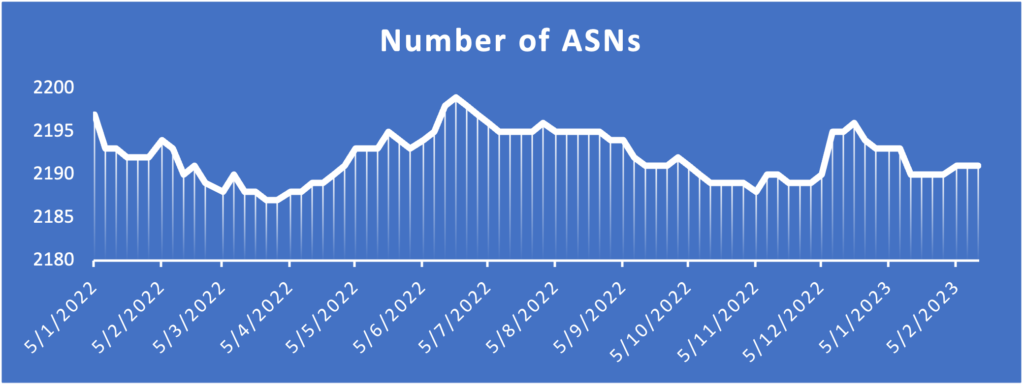
In the last 12 months, more than 100 network registrations have moved out of Ukraine. More than 40 of these are now registered in Russia (Table 1).
| 24 February 2022 | 19 February 2023 | 24 February 2022 | 19 February 2023 | 24 February 2022 | 19 February 2023 |
| UA 12959 | RU 12959 | UA 42301 | RU 42301 | UA 47379 | RU 47379 |
| UA 196705 | RU 196705 | UA 42393 | RU 42393 | UA 47939 | RU 47939 |
| UA 197129 | RU 197129 | UA 42394 | RU 42394 | UA 48711 | RU 48711 |
| UA 197880 | RU 197880 | UA 42511 | RU 42511 | UA 49075 | RU 49075 |
| UA 199908 | RU 199908 | UA 42518 | RU 42518 | UA 49536 | RU 49536 |
| UA 21087 | RU 21087 | UA 42534 | RU 42534 | UA 49803 | RU 49803 |
| UA 24758 | RU 24758 | UA 43564 | RU 43564 | UA 50210 | RU 50210 |
| UA 29031 | RU 29031 | UA 43802 | RU 43802 | UA 51153 | RU 51153 |
| UA 31387 | RU 31387 | UA 44240 | RU 44240 | UA 56676 | RU 56676 |
| UA 41039 | RU 41039 | UA 44269 | RU 44269 | UA 57093 | RU 57093 |
| UA 41082 | RU 41082 | UA 44584 | RU 44584 | UA 8381 | RU 8381 |
| UA 41308 | RU 41308 | UA 44857 | RU 44857 | UA 8654 | RU 8654 |
| UA 41479 | RU 41479 | UA 44878 | RU 44878 | ||
| UA 41914 | RU 41914 | UA 47124 | RU 47124 | ||
| UA 42104 | RU 42104 | UA 47243 | RU 47243 |
Interestingly, the RIPE NCC transfer data shows that only the following five ASNs have been transferred in the last 12 months:
- AS12959 Anton Bobrovnikov Teleradiocompany Nadezhda Ltd 13/09/2022 POLICY
- AS210877 Towse’e Saman Information Technology Co. PJS TS Information Technology Limited 09/12/2022 POLICY
- AS41039 Timer, LLC LLC “FTICOM” 30/09/2022 POLICY
- AS44269 Informational-measuring systems Ltd. Electro-Communication Telecom Ltd 23/12/2022 POLICY
- AS198654 PEKITEL Ltd. Ltd. Alfa Telecom 31/01/2017 POLICY AS48654 RTK-centr ltd. Balnet Ltd. 08/03/2022 POLICY
Why all of the 43 ASNs mentioned in the table above are not shown in the RIPE NCC transfer data is not clear to me. It could be due to the NWI-10 policy, which updated the country codes in delegated statistics: perhaps these networks changed their addresses from Ukraine to Russia.
Learn more about the RIPE NW1-10 policy and about its impact on the delegation statistics.
Table 2 shows which of the 100 moved or deregistered ASNs are now listed as Available or Reserved in the delegation file. These ASNs could be reassigned to other entities in the RIPE region.
| 24 February 2022 | 19 February 2023 | 24 February 2022 | 19 February 2023 |
| UA 197361 | ZZ 197361 reserved | UA 198306 | ZZ 198306 available |
| UA 197433 | ZZ 197433 reserved | UA 29249 | ZZ 29249 available |
| UA 198439 | ZZ 198439 reserved | UA 39333 | ZZ 39333 available |
| UA 206424 | ZZ 206424 reserved | UA 39693 | ZZ 39693 available |
| UA 210071 | ZZ 210071 reserved | UA 40965 | ZZ 40965 available |
| UA 24896 | ZZ 24896 reserved | UA 41158 | ZZ 41158 available |
| UA 28926 | ZZ 28926 reserved | UA 41348 | ZZ 41348 available |
| UA 31448 | ZZ 31448 reserved | UA 41873 | ZZ 41873 available |
| UA 33851 | ZZ 33851 reserved | UA 42502 | ZZ 42502 available |
| UA 35406 | ZZ 35406 reserved | UA 44803 | ZZ 44803 available |
| UA 42434 | ZZ 42434 reserved | UA 47235 | ZZ 47235 available |
| UA 44487 | ZZ 44487 reserved | UA 48280 | ZZ 48280 available |
| UA 47600 | ZZ 47600 reserved | ||
| UA 57025 | ZZ 57025 reserved | ||
| UA 60298 | ZZ 60298 reserved |
Figure 2 and Table 3 show the other countries in which the ASNs previously allocated to networks in Ukraine have ended up.
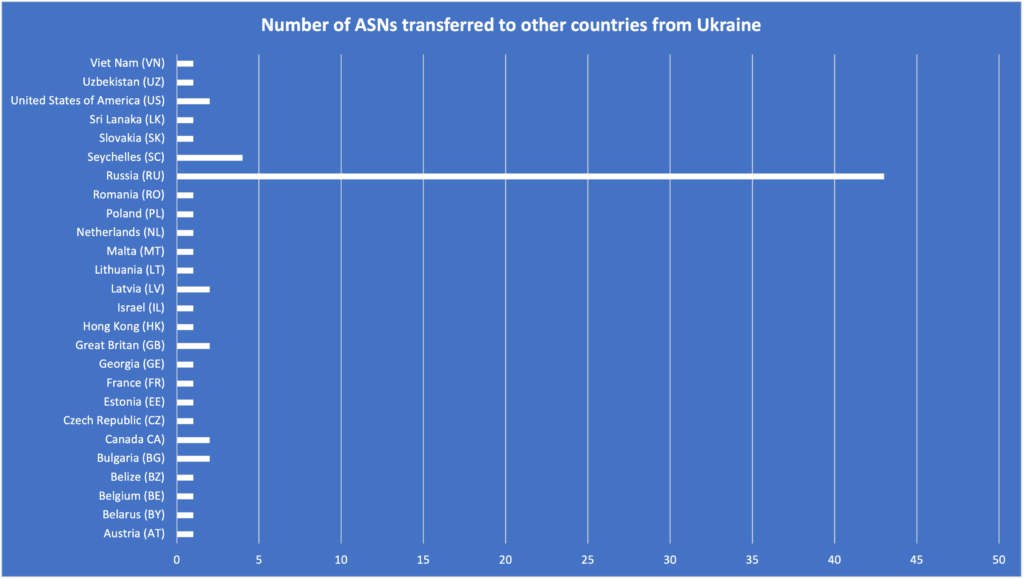
| 24 February 2022 | 19 February 2023 | 24 February 2022 | 19 February 2023 |
| UA 196741 | GB 196741 | UA 34046 | SC 34046 |
| UA 197335 | GE 197335 | UA 34633 | SK 34633 |
| UA 198109 | US 198109 | UA 42564 | PL 42564 |
| UA 202580 | SC 202580 | UA 43123 | LV 43123 |
| UA 204789 | GB 204789 | UA 47517 | LK 47517 |
| UA 206053 | BY 206053 | UA 47752 | UZ 47752 |
| UA 206439 | VN 206439 | UA 48440 | BG 48440 |
| UA 206447 | RO 206447 | UA 49704 | BG 49704 |
| UA 20724 | CA 20724 | UA 50297 | LT 50297 |
| UA 210119 | SC 210119 | UA 50499 | CA 50499 |
| UA 210132 | HK 210132 | UA 51306 | FR 51306 |
| UA 210138 | BZ 210138 | UA 56421 | EE 56421 |
| UA 212187 | US 212187 | UA 58215 | CZ 58215 |
| UA 212389 | BE 212389 | UA 61336 | SC 61336 |
| UA 25053 | AT 25053 | UA 61357 | NL 61357 |
| UA 25235 | IL 25235 | UA 61376 | LV 61376 |
| UA 28776 | MT 28776 |
Out of the 33 ASN mentioned above, the following six ASNs were transferred to other entities per the RIPE NCC resource transfer policy:
- AS196741 LLC “IT HOME” Dataart Solutions Inc. 09/12/2019 POLICY AS196741 DataArt_Technologies UK Ltd LLC “IT HOME” 01/06/2022 POLICY
- AS197335 Artem Zubkov Freebit LLC 02/11/2022 POLICY
- AS206447 LLHOST INC. SRL LLHost Inc 13/10/2022 POLICY
- AS28776 ISV TECH LIMITED SoftServe Ltd. 22/06/2022 POLICY
- AS34633 Tiramix s.r.o. UKRINDEX LLC 15/02/2023 POLICY
- AS56421 Eurolir OU LLC “WEECOMI UKRAINE” 27/12/2022 POLICY
IPv4 and IPv6 Address Space
There has been a clear decline in IPv4 address block allocations to Ukraine in the last 12 months (Figure 3).
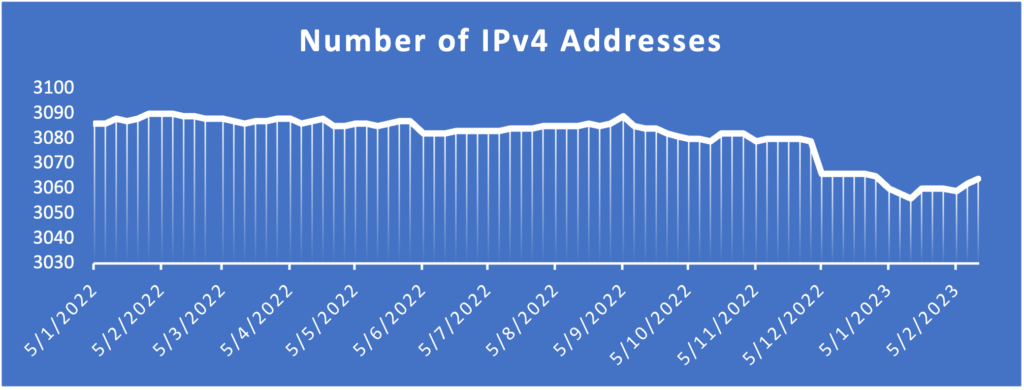
However, just like ASNs, many IPv4 and IPv6 address blocks have been assigned to networks in Ukraine, and many have moved out.
For example, 29 /24 IPv4 blocks (7,424 IPv4 addresses) were allocated by RIPE NCC to networks in Ukraine in the last 12 months.
If we look at the number of IPv6 addresses (Figure 4), we can see a definitive drop—5% in total—in the last 12 months. Of these:
- Five IPv6 address blocks were returned to RIPE NCC to be reallocated.
- 33 IPv6 address blocks were either transferred to other networks outside Ukraine or the resource holders changed their country of origin from Ukraine to others countries. Note: all of these were transferred to LVNET Ltd, a service provider based in Cyprus.

While some networks disappeared from the global routing table, we also witnessed some resilience. For example, on 3 March 2022, AS6712 – FORMAT-TV-AS, based in Mariupol, disappeared from the global routing table (Figure 5). It returned after a month but with only half of the address space that it was using.
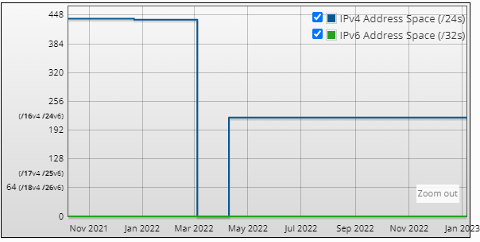
Other large networks from the same region, such as AS57864 – MEGABIT and AS35714 – Infoservice-UA, also disappeared around the same time but did not return.
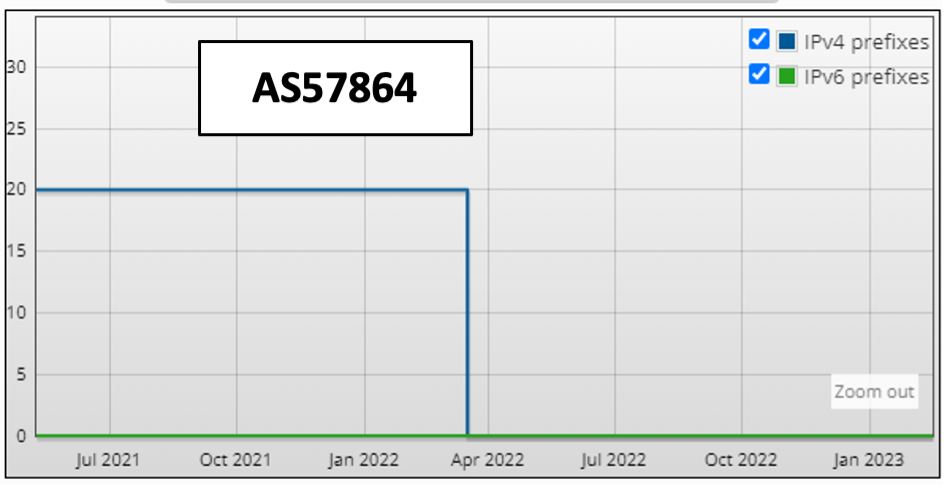
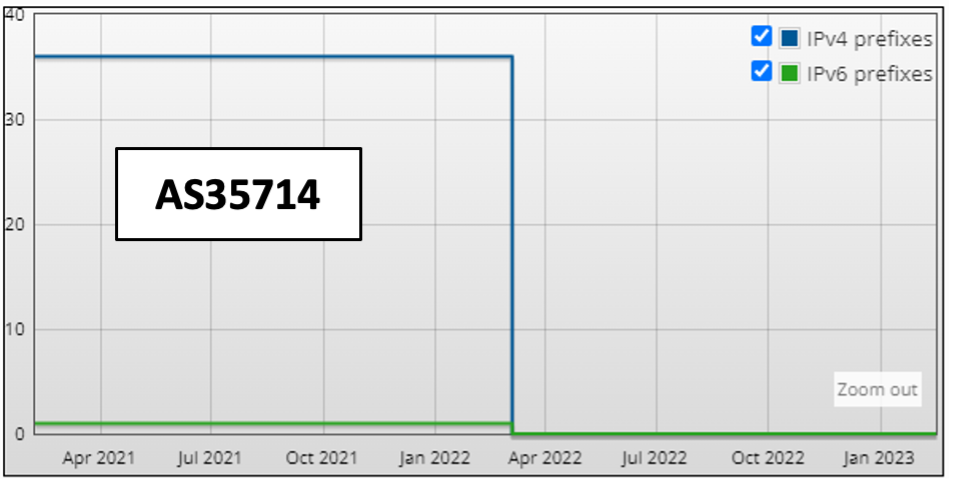
Impact on Internet Users
Any network or routes disappearing from the global routing table portrays a grave picture because these are not just networks or IP addresses that are no longer in use. There are people behind the scenes operating and maintaining these networks. And there are people using these IP addresses to connect to the Internet for knowledge, information, and news, and to connect with their loved ones. All of these things become so much more important during times of hardship.
We will continue to monitor and report on these changes and subsequent Internet events, and look into the effect they have on Ukraine and the rest of the world.
Subscribe to the Pulse monthly newsletter to stay up to date.

